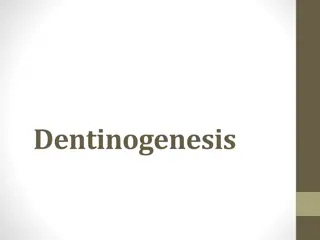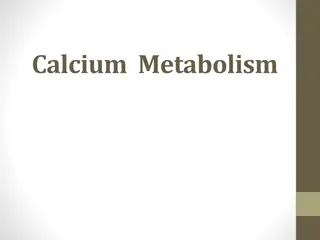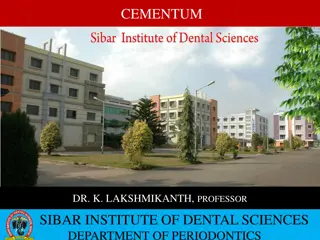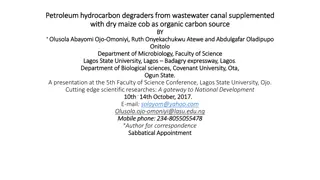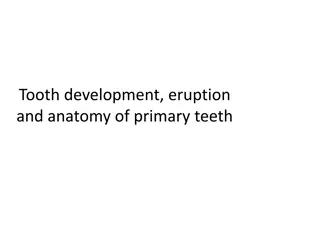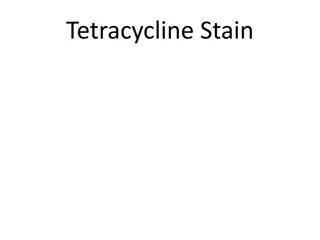Understanding Dentinogenesis: A Comprehensive Overview
Dentinogenesis is a crucial process in tooth development starting at the cusp tips as odontoblasts differentiate and begin collagen production. Factors like TGF, IGF, and BMP play key roles in organizing odontoblast cytoskeleton assembly. Odontoblasts take up calcium, maintain high concentrations, a
0 views • 38 slides
Understanding Dental Calculus Formation and Classification
Dental calculus, also known as tartar, is a mineralized bacterial plaque that forms on natural teeth and dental prostheses. It can be classified as supragingival or subgingival based on its relation to the gingival margin. This hard deposit is formed through the mineralization of dental plaque and c
5 views • 36 slides
Understanding Calcium Metabolism: A Comprehensive Overview
Calcium metabolism plays a critical role in various bodily functions like nerve conduction, coagulation, and bone mineralization. It involves processes such as calcium absorption, distribution, and homeostasis, regulated by hormones like PTH and calcitriol. The balance of calcium in the body is cruc
7 views • 50 slides
Understanding Cementum in Dental Anatomy
Cementum is a vital component of the tooth root, forming a protective layer. It is a calcified tissue with specific constituents and chemical composition. Cementogenesis involves a complex process of differentiation and mineralization, regulated by key molecular factors. Cells like cementoblasts and
0 views • 42 slides
Overview of Treatment with Reverse Osmosis (Desalination)
Reverse osmosis (RO) is a treatment method used in challenging water treatment situations to remove contaminants effectively. It requires pre-treatment and remineralization, making it suitable for mineral and chemical contamination. RO systems need careful maintenance to prevent fouling and membrane
0 views • 6 slides
Understanding Rickets: Causes, Symptoms, and Pathophysiology
Rickets is a metabolic bone disorder primarily caused by deficiencies in vitamin D, calcium, or phosphorus. This leads to softening and weakening of bones, affecting bone growth and remodeling. Genetic, nutritional, and hormonal abnormalities contribute to this condition, impacting young growing ani
0 views • 16 slides
Evaluation of Petroleum Hydrocarbon Degraders in Wastewater Canal Supplemented with Organic Carbon Source
This study explores the potential of native bacterial populations in wastewater for bioremediation of petroleum hydrocarbon-polluted environments. The research involved exposing Bonny light crude oil to wastewater canal samples supplemented with dry maize cob as an organic carbon source. Results sho
0 views • 26 slides
Microbial Transformations of Nitrogen in Soil: Factors, Forms, and Impact on Plant Nutrition
Understanding the microbial transformations of nitrogen in soil is crucial for optimizing plant nutrition. Factors such as climate, water supply, cultivation, soil texture, and depth influence the nitrogen content in soil. The different forms of soil nitrogen, including inorganic and organic compoun
0 views • 23 slides
Understanding Primary Tooth Development and Eruption
Explore the stages of tooth development and eruption in primary teeth, from induction to eruption, with details on mineralization, eruption times, symptoms, disturbances, and primary dentition characteristics. Learn about common issues and the relationship between primary teeth and permanent teeth.
0 views • 12 slides
Portfolio of Advanced Gold Projects in Argentina
Explore a portfolio of advanced gold projects in Argentina, showcasing the country's geological mining potential through preliminary economic assessments, feasibility studies, and advanced exploration initiatives. Discover detailed information on various projects like Calcatreu, Suyai, Taguas, and m
0 views • 14 slides
Geology and Magmatism in Canadian Cordilleran Terranes
The content discusses the geological features of Cordilleran terranes in Canada, including the Stikine and Quesnel arcs, Cache Creek, Slide Mountain, and more. It delves into the relationship between magmatism, porphyry mineralization, and subduction processes, highlighting the Kutcho-Sitlika-Venabl
0 views • 14 slides
Understanding Tetracycline Stain in Teeth Development
Tetracycline stain can lead to discoloration during teeth development due to the antibiotic's affinity for mineralized tissues. This intrinsic stain originates from within the tooth and cannot be removed by scaling. The impact on pregnant women and infants is significant as tetracycline can affect m
0 views • 11 slides
